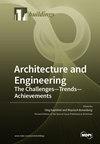考虑机械损伤演变的普通混凝土和高强度混凝土内部阻尼比
IF 3.1
3区 工程技术
Q2 CONSTRUCTION & BUILDING TECHNOLOGY
引用次数: 0
摘要
本文大大扩展了对正常强度混凝土(NSC)和高强度混凝土(HSC)在未损坏和损坏条件下的内部阻尼比的研究。本研究考察了抗压强度在 42 到 83 兆帕之间的混凝土。使用伺服控制液压试验机施加循环荷载,并通过声学试验确定每个循环步骤的动态弹性模量(Ed)和内部阻尼比(ξ)。结果表明,正常强度混凝土(fc=42 兆帕)的未破坏内部阻尼比ξ=0.5%,在破坏指数为 0.8 时达到最大值ξ=2.5%。相反,高强度混凝土混合物(fc=83 兆帕)的未破坏内部阻尼比为ξ=0.29%,在破坏指数为 0.32 时达到峰值ξ=0.93%。初始内部阻尼值受到孔隙率和过渡区的影响,而孔隙率和过渡区会影响材料在循环载荷下的行为。渐进损伤会导致开裂过程中库仑阻尼的增加。很少有研究对循环载荷诱导损伤下的内部阻尼比进行量化和理解,这项研究有助于我们理解 NSC 和 HSC 在动态激励和损伤演变下的行为,尤其是在冲击情况下。本文章由计算机程序翻译,如有差异,请以英文原文为准。
Internal Damping Ratio of Normal- and High-Strength Concrete Considering Mechanical Damage Evolution
This paper significantly extends investigations into internal damping ratios in both undamaged and damaged conditions for normal-strength concretes (NSCs) and high-strength concretes (HSCs). This study examines concretes with compressive strengths ranging from 42 to 83 MPa. Cyclic loads were applied using a servo-controlled hydraulic testing machine, and for each cyclic step, the dynamic elastic modulus (Ed) and internal damping ratio (ξ) were determined through acoustic tests. The results show that the normal-strength concretes (fc=42 MPa) exhibited an undamaged internal damping ratio of ξ=0.5%, reaching a maximum of ξ=2.5% at a damage index of 0.8. Conversely, the high-strength concrete mixtures (fc=83 MPa) showed an undamaged internal damping ratio of ξ=0.29%, with a peak value of ξ=0.93% at a damage index of 0.32. The initial internal damping values are influenced by porosity and transition zones, which affect the material behavior under cyclic loads. Progressive damage leads to increased Coulomb damping due the cracking process. Few studies have quantified and comprehended the internal damping ratio under cyclic loading-induced damage, and this research advances our understanding of NSC and HSC behavior under dynamic excitation and damage evolution, especially in impact scenarios.
求助全文
通过发布文献求助,成功后即可免费获取论文全文。
去求助
来源期刊

Buildings
Multiple-
CiteScore
3.40
自引率
26.30%
发文量
1883
审稿时长
11 weeks
期刊介绍:
BUILDINGS content is primarily staff-written and submitted information is evaluated by the editors for its value to the audience. Such information may be used in articles with appropriate attribution to the source. The editorial staff considers information on the following topics: -Issues directed at building owners and facility managers in North America -Issues relevant to existing buildings, including retrofits, maintenance and modernization -Solution-based content, such as tips and tricks -New construction but only with an eye to issues involving maintenance and operation We generally do not review the following topics because these are not relevant to our readers: -Information on the residential market with the exception of multifamily buildings -International news unrelated to the North American market -Real estate market updates or construction updates
 求助内容:
求助内容: 应助结果提醒方式:
应助结果提醒方式:


